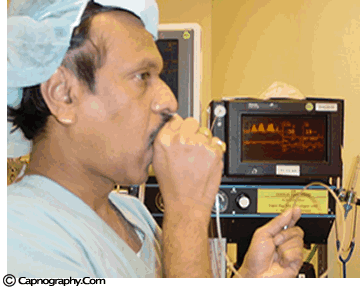Checking or test capnograph before clinical use
One should ascertain that the capnograph is functioning properly before making any interpretations of PETCO2 readings and waveforms. Secretions and mucus may contaminate the unit, and distort CO2 waveforms. Similarly, water may partially obstruct sampling lines resulting in distorted waveforms. A leak in the sampling tube may result in low PETCO2 measurements. Therefore, check the monitor to see if it is functioning properly.
The Biomedical Engineering Department should calibrate the capnograph periodically to ensure that it maintains “with-in range” calibrations.
A simple but less accurate method is to record a normal CO2 tracing (e.g. one’s own). The proper functioning of the capnograph is confirmed by a typical CO2 waveform with PETCO2 readings between 38 and 42 mm Hg.


 Twitter
Twitter Youtube
Youtube










